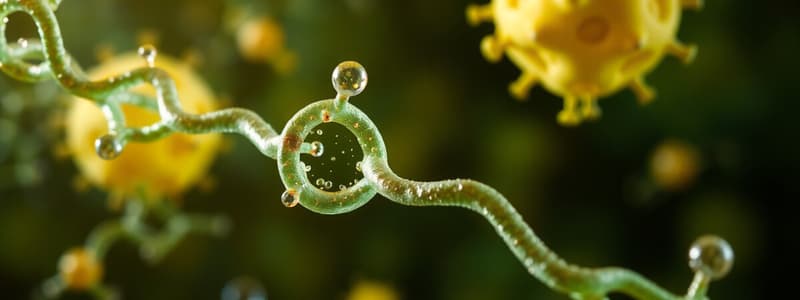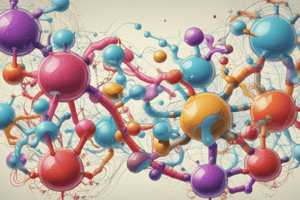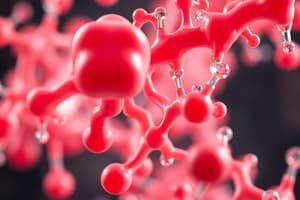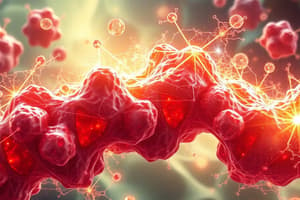Podcast
Questions and Answers
What does keratin primarily form in the body?
What does keratin primarily form in the body?
- Nail and hair structures (correct)
- Enzymes
- Bone structures
- Muscle tissue
Translation occurs in the nucleus.
Translation occurs in the nucleus.
False (B)
What is the role of mRNA during protein synthesis?
What is the role of mRNA during protein synthesis?
To carry the coded message from DNA to the ribosome.
The process of making mRNA from DNA is called __________.
The process of making mRNA from DNA is called __________.
Match the components of protein synthesis to their roles:
Match the components of protein synthesis to their roles:
What is the primary function of enzymes in biological reactions?
What is the primary function of enzymes in biological reactions?
Enzymes can be used up in a reaction and are therefore not reusable.
Enzymes can be used up in a reaction and are therefore not reusable.
What structure binds to the enzyme at its active site?
What structure binds to the enzyme at its active site?
Enzymes are most active at an optimum temperature of _____ degrees Celsius in humans.
Enzymes are most active at an optimum temperature of _____ degrees Celsius in humans.
Match the following types of enzyme inhibition with their characteristics:
Match the following types of enzyme inhibition with their characteristics:
Which of the following describes non-competitive inhibition?
Which of the following describes non-competitive inhibition?
Enzymes can exhibit allosteric regulation where certain substances can enhance their activity.
Enzymes can exhibit allosteric regulation where certain substances can enhance their activity.
Name the two main processes that enzymes are involved in.
Name the two main processes that enzymes are involved in.
Cells control enzyme activity by _____ the production of specific enzymes.
Cells control enzyme activity by _____ the production of specific enzymes.
What is the primary function of enzymes?
What is the primary function of enzymes?
Enzymes change their structure permanently after a chemical reaction.
Enzymes change their structure permanently after a chemical reaction.
What are the two main types of enzymes?
What are the two main types of enzymes?
Which nitrogenous bases are classified as pyrimidines?
Which nitrogenous bases are classified as pyrimidines?
The hypothesis that describes how substrates bind to enzymes is known as the __________ hypothesis.
The hypothesis that describes how substrates bind to enzymes is known as the __________ hypothesis.
Match the following terms with their definitions:
Match the following terms with their definitions:
The semiconservative model of DNA replication ensures that each daughter cell receives a complete copy of the original DNA.
The semiconservative model of DNA replication ensures that each daughter cell receives a complete copy of the original DNA.
Which factor does NOT affect enzyme activity?
Which factor does NOT affect enzyme activity?
What is the role of helicase during DNA replication?
What is the role of helicase during DNA replication?
Name one example of a chemical reaction that occurs with the help of enzymes.
Name one example of a chemical reaction that occurs with the help of enzymes.
The two strands of DNA run in opposite directions, which is referred to as __________.
The two strands of DNA run in opposite directions, which is referred to as __________.
Match the components of DNA replication with their functions:
Match the components of DNA replication with their functions:
Which enzyme replaces the RNA primer during DNA replication?
Which enzyme replaces the RNA primer during DNA replication?
What is the role of allosteric sites in enzymes?
What is the role of allosteric sites in enzymes?
The lagging strand is synthesized continuously during DNA replication.
The lagging strand is synthesized continuously during DNA replication.
An immobilized enzyme allows for repeated use of the same batch.
An immobilized enzyme allows for repeated use of the same batch.
What is the purpose of the single-stranded binding proteins during DNA replication?
What is the purpose of the single-stranded binding proteins during DNA replication?
Guanine pairs with __________ through triple hydrogen bonds.
Guanine pairs with __________ through triple hydrogen bonds.
What is the function of messenger RNA (mRNA)?
What is the function of messenger RNA (mRNA)?
What is the direction of synthesis for DNA polymerase III?
What is the direction of synthesis for DNA polymerase III?
DNA stands for __________.
DNA stands for __________.
Match the following components with their descriptions:
Match the following components with their descriptions:
Which of the following statements about nucleotides is true?
Which of the following statements about nucleotides is true?
Cytosine pairs with Thymine in both DNA and RNA.
Cytosine pairs with Thymine in both DNA and RNA.
What is the shape of DNA?
What is the shape of DNA?
The primary sugar found in RNA is __________.
The primary sugar found in RNA is __________.
What benefit does immobilizing enzymes provide in industries?
What benefit does immobilizing enzymes provide in industries?
Flashcards
Enzyme Active Site
Enzyme Active Site
The specific region of an enzyme where a substrate molecule binds and undergoes a chemical reaction.
Enzyme Substrate
Enzyme Substrate
The molecule acted upon by an enzyme.
Lock and Key Model
Lock and Key Model
An outdated model of enzyme action where the enzyme's active site is rigid and perfectly matches the substrate.
Induced Fit Model
Induced Fit Model
Signup and view all the flashcards
Enzyme function
Enzyme function
Signup and view all the flashcards
Enzyme types
Enzyme types
Signup and view all the flashcards
Enzyme activity factors
Enzyme activity factors
Signup and view all the flashcards
Enzyme activity optimum temp.
Enzyme activity optimum temp.
Signup and view all the flashcards
Enzyme denaturation
Enzyme denaturation
Signup and view all the flashcards
Active site
Active site
Signup and view all the flashcards
Competitive inhibition
Competitive inhibition
Signup and view all the flashcards
Non-competitive inhibition
Non-competitive inhibition
Signup and view all the flashcards
Allosteric site
Allosteric site
Signup and view all the flashcards
Enzyme inhibition (prevent activity)
Enzyme inhibition (prevent activity)
Signup and view all the flashcards
Immobilized enzyme
Immobilized enzyme
Signup and view all the flashcards
Enzyme immobilization benefits
Enzyme immobilization benefits
Signup and view all the flashcards
DNA
DNA
Signup and view all the flashcards
Gene
Gene
Signup and view all the flashcards
Nucleotide
Nucleotide
Signup and view all the flashcards
DNA structure
DNA structure
Signup and view all the flashcards
Chargaff's base pair rule
Chargaff's base pair rule
Signup and view all the flashcards
RNA
RNA
Signup and view all the flashcards
Types of RNA
Types of RNA
Signup and view all the flashcards
Protein function
Protein function
Signup and view all the flashcards
What is the role of DNA in protein synthesis?
What is the role of DNA in protein synthesis?
Signup and view all the flashcards
What are the 3 assistant directors in protein synthesis?
What are the 3 assistant directors in protein synthesis?
Signup and view all the flashcards
What is Transcription?
What is Transcription?
Signup and view all the flashcards
What happens during Transcription?
What happens during Transcription?
Signup and view all the flashcards
What is the role of the Ribosome in protein synthesis?
What is the role of the Ribosome in protein synthesis?
Signup and view all the flashcards
Pyrimidine bases
Pyrimidine bases
Signup and view all the flashcards
Purine bases
Purine bases
Signup and view all the flashcards
Base pairing in DNA
Base pairing in DNA
Signup and view all the flashcards
DNA replication purpose
DNA replication purpose
Signup and view all the flashcards
Semiconservative replication
Semiconservative replication
Signup and view all the flashcards
Antiparallel strands in DNA
Antiparallel strands in DNA
Signup and view all the flashcards
Helicase enzyme
Helicase enzyme
Signup and view all the flashcards
RNA Primase
RNA Primase
Signup and view all the flashcards
DNA polymerase III
DNA polymerase III
Signup and view all the flashcards
Leading strand
Leading strand
Signup and view all the flashcards
Study Notes
Enzyme Action
- Enzymes are proteins that act as catalysts, speeding up chemical reactions.
- Enzymes catalyze one specific reaction.
- Active site: a region of the enzyme where the substrate binds.
- Substrate: the molecule that the enzyme acts upon.
- Enzyme-substrate complex: formed when the substrate binds to the active site.
- Products: formed when the substrate is broken down or new bonds are formed.
- Lock and key model: the active site has a rigid shape that perfectly complements the substrate.
- Induced fit model: the active site changes shape slightly to accommodate the substrate, creating a tighter fit.
- Enzymes do not get used up in the reaction, they can be reused.
- Endoenzymes: act within the cells where they are produced (intracellular).
- Exoenzymes: act outside the cells where they are produced (extracellular).
Factors Affecting Enzyme Activity
- Temperature: Enzymes work best at specific temperatures.
- pH: Optimal pH levels exist for enzymes.
- Substrate concentration: Higher substrate concentration generally leads to faster reaction rates up to a certain point.
- Enzyme concentration: Higher enzyme concentration generally leads to faster reaction rates up to a certain point.
Enzyme Inhibition
- Competitive inhibition: a molecule similar to the substrate competes for the active site.
- Non-competitive inhibition: a molecule binds to a site other than the active site (allosteric site), changing the active site's shape.
- Allosteric regulation: a molecule called an activator or inhibitor binds to an allosteric site, changing the enzyme's activity.
Immobilized Enzymes
- Immobilized enzymes are enzymes that are attached to a solid material.
- This allows for easier separation of products, reuse of the enzyme, and control of reaction conditions.
- Useful in industrial processes and food production.
DNA
- DNA makes up genes, which are blueprints for the human body.
- DNA is made up of nucleotides.
- Nucleotides are the basic units of DNA.
- DNA has a double helix shape.
- DNA is made up of 3 components: a sugar, a phosphate and a nitrogenous base.
- The rule (Chargaff's base-pair rule): Adenine (A) always pairs with Thymine (T), and Cytosine (C) always pairs with Guanine (G).
RNA
- RNA is a ribonucleic acid.
- Created from DNA replication.
- Single-stranded.
- RNA has different types including Messenger RNA (mRNA), Transfer RNA (tRNA), and Ribosomal RNA (rRNA).
- RNA contains a sugar (ribose), a phosphate group, and a nitrogenous base.
- The nitrogenous bases in RNA are adenine (A), cytosine (C), guanine (G), and uracil (U).
DNA Replication
- DNA replication is the process of creating an identical copy of a DNA molecule.
- Semiconservative model: each new DNA molecule contains one original strand and one new strand.
Protein Synthesis
- Protein synthesis involves two main stages: transcription and translation.
- Transcription: the process of making mRNA from DNA.
- Translation: the process of making a polypeptide chain (protein) from mRNA.
- Proteins are made up of amino acids.
- The genetic code is used to determine the sequence of amino acids in a protein.
Gene Mutations
- A mutation is an alteration of the nucleotide sequence of the DNA.
- Mutations can be helpful, harmful, or neutral.
- Point mutations: change in one DNA base pair.
- Frameshift mutations: insertion or deletion of one or more DNA base pairs, shifting the reading frame for subsequent codons.
Genetic Code (codon table)
- A three-letter sequence of nucleotides (codon) specifies a particular amino acid.
Studying That Suits You
Use AI to generate personalized quizzes and flashcards to suit your learning preferences.




